Explore Okayama - Japan Travel, Asia
Nestled in the western part of Japan's Okayama Prefecture, Okayama is a gem of a destination that offers a delightful mix of history, culture, and modern attractions. Often referred to as the “Sunny Land” due to its favorable climate, Okayama boasts a rich historical and cultural heritage. Whether you're a history enthusiast, a foodie, or simply looking to explore Japan’s lesser-known treasures, Okayama has something special to offer.
Looking for an unforgettable journey through Japan? Explore our premium tours here and start planning your adventure
Population: Approximately 700,000 in 2023.
Economy: Okayama's economy sees the rise in GDP of tourism, agriculture, and machine tools. The most notable products from this region include rice, eggplant, and white Chinese chives.
Landmarks: Famous for Okayama Castle (or the “Crow Castle”), Korakuen Garden, and Kibiji District.
Japan

Overview of Okayama
History & Cultural Influence
Okayama’s history is steeped in samurai tradition and cultural significance. The city’s strategic location has made it a pivotal point in Japan’s history, particularly during the Edo period. Key historical sites such as Okayama Castle provide a glimpse into the region’s feudal past. Okayama Castle, popularly known as "Crow Castle" for its black façade, was built in 1597 and is the most visible reminder of the city's past legacy. The cultural heritage of Okayama extends beyond its historical landmarks. The city has played a significant role in Japanese culture, from its traditional arts to its regional festivals. The influence of Okayama's history is evident in its well-preserved architecture, local crafts, and cultural practices that continue to thrive today.
Interaction with The Locals
Okayama, a vibrant city in Japan's western region, has a population of approximately 700,000 residents. The city's inhabitants are known for their friendly and welcoming demeanor, reflecting the region’s rich cultural heritage. The local community takes pride in their traditions and actively participates in various cultural and social events, contributing to Okayama’s unique charm and hospitable atmosphere.
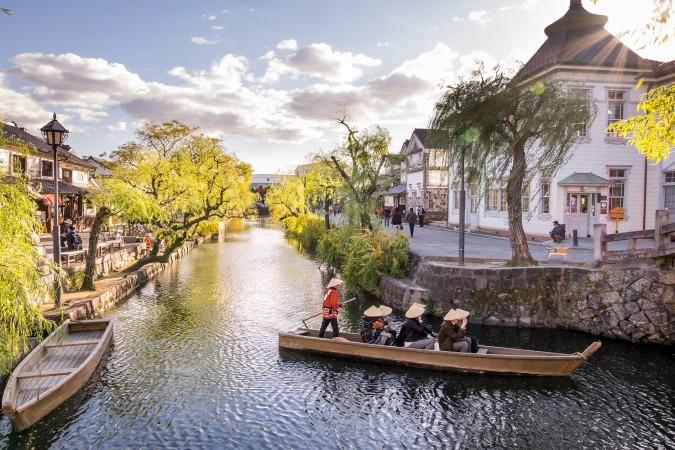
Kurashiki Bikan Historical Quarter in Okayama - © EVA
Top Attractions in Okayama
Okayama is brimming with attractions that cater to a variety of interests. These attractions make Okayama a diverse and engaging destination, offering a blend of historical, cultural, and recreational experiences.
- Okayama Castle: Okayama Castle, known as the "Crow Castle" because of its black exterior, is a magnificent example of Japanese castle construction that provides expansive views of the city and its surroundings. The castle grounds are perfect for a leisurely stroll, and the historical exhibits provide insight into the region’s past.
- Korakuen Garden: Ranked among Japan’s top three landscape gardens, Korakuen is a tranquil retreat with meticulously designed landscapes, seasonal flowers, and serene ponds. The garden provides a peaceful escape and is ideal for a relaxing afternoon.
- Kibiji District: This area is renowned for its historical sites, including ancient tombs and shrines. The district’s rich cultural heritage and archaeological treasures make it a fascinating place to explore.
- Shiraishi Island: Known for its pristine beaches and crystal-clear waters, Shiraishi Island is a popular spot for relaxation and swimming. The relaxed environment of the island makes it the ideal place to get away from the metropolis.
- Naoshima: Famous for its modern art museums and sculptures, Naoshima is an island that blends contemporary art with natural beauty. Highlights include the Chichu Art Museum and the Benesse House Museum.
- Bizen Pottery Village: This region, which is close by in the city of Bizen, is well known for its authentic Bizen pottery. Visitors can explore local workshops, view exquisite ceramic pieces, and even try their hand at pottery-making.
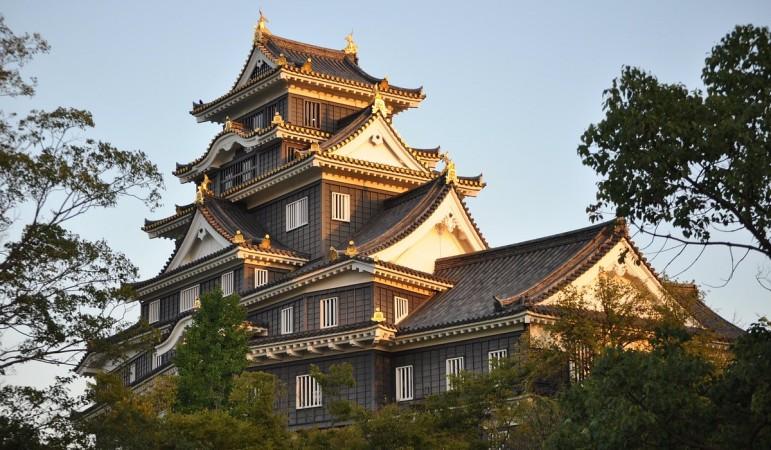
Okayama Castle - © Japan Tourism
Must-Try Dishes in Okayama
Okayama’s culinary tradition is a delightful exploration of regional flavors and traditional Japanese cuisine. These dishes not only reflect the region’s culinary heritage but also provide a delicious experience of Okayama’s unique flavors.
- Kibi Dango: A famous local sweet, Kibi Dango is a chewy, flour-based treat often enjoyed as a snack. Made from roasted soybean flour, it's a simple yet delicious confection that has been a favorite in Okayama for generations.
- Okayama Peach: Known for its sweetness and juiciness, the Okayama Peach is a prized fruit. This seasonal delicacy is often eaten fresh or used in desserts, providing a refreshing taste of summer.
- Bara-zushi: This traditional sushi dish features a colorful assortment of sashimi and vegetables arranged on a bed of vinegared rice. Bara-zushi is frequently consumed at festivals and special events.
- Okayama Ramen: Unique to the region, Okayama Ramen is characterized by its rich, savory broth and tender noodles. Often topped with pork, green onions, and a soft-boiled egg, it offers a hearty and satisfying meal.
- Fried Oyster: Okayama is known for its high-quality oysters. Fried oysters, served crispy on the outside and tender on the inside, are a local favorite and a must-try for seafood enthusiasts.
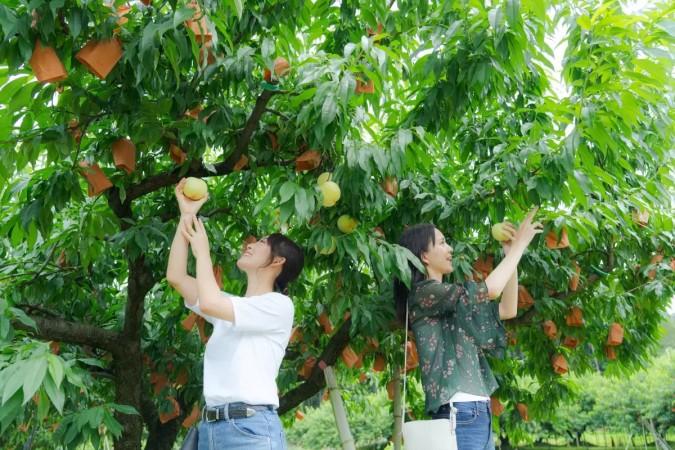
Harvest peach in Okayama Peach orchard - © Okayama Tourism Official
Festivals & Local Celebrations
Okayama's vibrant cultural calendar is marked by a range of festivals and celebrations that highlight the city’s rich traditions. These festivals not only provide entertainment but also offer deeper insights into Okayama’s cultural practices and community spirit.
Okayama Momotaro Festival
Held annually in August, the Okayama Momotaro Festival is a lively celebration honoring the legendary hero Momotaro, who is said to have been born from a giant peach. The festival features an array of activities, including colorful parades, traditional music, and dance performances. The lively "Momotaro Dance," in which performers and onlookers join in to honor the city's heritage, is one of the highlights. The festival attracts large crowds, creating a festive atmosphere with street vendors, food stalls, and local craft exhibitions.
Bizen Pottery Festival
This October festival is dedicated to Bizen ware, one of Japan's oldest and most distinctive types of pottery. The Bizen Pottery Festival showcases the intricate craftsmanship and unique styles of Bizen ceramics through exhibitions, demonstrations, and workshops. Visitors can watch skilled artisans at work, participate in pottery-making sessions, and purchase one-of-a-kind ceramic products directly from the makers. The festival enhances the whole experience with local flavors and customs by offering a variety of cultural acts and food vendors.
Okayama Lantern Festival
Taking place in early February, the Okayama Lantern Festival transforms the city into a magical landscape illuminated by thousands of lanterns. The festival, which marks the start of the Lunar New Year, includes a grand parade featuring lanterns of all shapes and sizes, creating a dazzling display of light and color. Tourists may take part in celebratory festivities, see traditional performances, and stroll through streets and parks decorated with lanterns. The festival’s enchanting ambiance provides a unique way to experience Okayama’s winter charm.
Explore the unique charm of Tateshina, another must-visit place in Japan, in our article here.
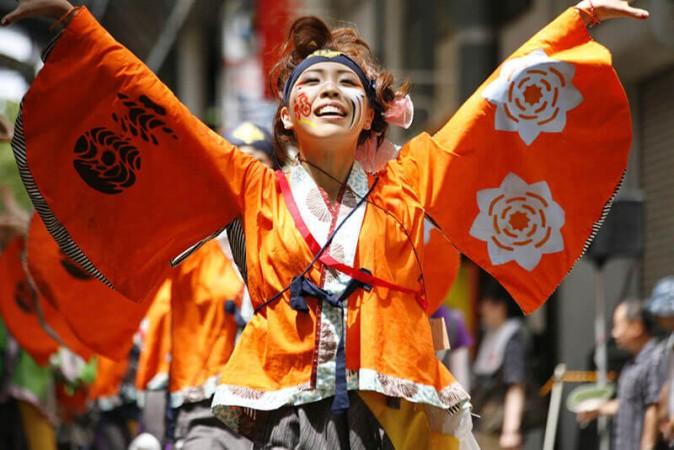
Okayama Momotaro Festival - © Momotaro Festival Official
What to Do in Okayama
Okayama offers a diverse array of activities to suit all interests and tastes. Whether you're exploring historical sites, engaging in cultural activities, or enjoying the natural landscape, Okayama offers a variety of experiences that cater to every traveler’s interests.
- Explore Outdoor Adventures: Embrace the natural beauty of Okayama by hiking the scenic trails in and around the city. Enjoy bike rides through picturesque landscapes and parks, such as the Korakuen Garden and Mount Washu. These outdoor activities offer a refreshing way to experience Okayama’s natural charm.
- Hands-On Traditional Crafts: Dive into Okayama’s rich craft heritage by participating in workshops that showcase traditional skills. Try your hand at Bizen pottery, known for its distinctive style, or explore textile weaving in local craft centers. These hands-on experiences provide insight into the region’s artisanal traditions.
- Discover Historical Landmarks: Immerse yourself in Okayama’s history by visiting key landmarks like Okayama Castle and the Kibiji District. Uncover historical sites and learn about the city’s past, its feudal heritage, and its historical significance. With this, you will have a deeper understanding of Okayama’s cultural and historical context.
- Enjoy Local Festivals: Time your visit to coincide with one of Okayama’s vibrant festivals. Experience the lively Okayama Momotaro Festival in August, where you can enjoy parades and traditional dances. Alternatively, visit during the Bizen Pottery Festival in October to witness the region’s renowned ceramics and participate in pottery workshops.
- Shiraishi Island Wellness Retreat: Take a short trip to Shiraishi Island for a relaxing day by the beach. Swim in the clear waters, lounge on the sandy shores, and enjoy the island’s peaceful atmosphere. It’s an ideal spot for a break from city life and a chance to soak up some sun.
- Visit Naoshima Island: For a dose of contemporary art, head to Naoshima Island, famous for its modern art museums and outdoor sculptures. Explore the Chichu Art Museum and the Benesse House Museum to see a blend of art and natural beauty in a unique setting.
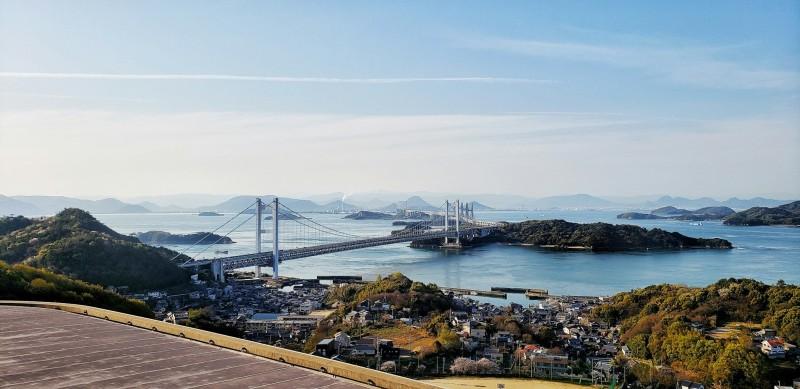
Plan your wellness retreat in Shiraishi Island - © Jeremy Lam
Weather in Okayama: Best Time to Visit
Okayama’s climate varies throughout the year, influencing tourism trends and activities. Understanding these seasonal trends helps you plan your visit to Okayama, ensuring you experience the city at its best throughout the year.
Spring in Okayama
Spring in Okayama is a delightful time for tourism with temperatures ranging from 10°C to 20°C (50°F to 68°F). The weather is nice and moderate. This season is perfect for cherry blossom viewing, especially in Korakuen Garden and Okayama Castle. The blooming flowers attract many visitors, making it a popular time for sightseeing and outdoor festivals.
Summer in Okayama
Summer brings warmer temperatures, typically ranging from 20°C to 30°C (68°F to 86°F). Even while the weather can get hot and muggy at times, this is a vibrant season with many celebrations, including the Okayama Momotaro Festival. Beach trips to nearby islands like Shiraishi Island become popular, and tourists enjoy outdoor activities despite the heat.
Autumn in Okayama
Autumn offers cooler temperatures, ranging from 15°C to 25°C (59°F to 77°F), and is one of the best times to visit Okayama. The season is marked by beautiful fall foliage, making it ideal for scenic walks and photography. Events like the Bizen Pottery Festival highlight the cultural scene, and the pleasant weather is perfect for exploring the city’s attractions.
Winter in Okayama
Winter in Okayama is relatively mild compared to other regions, with temperatures between 0°C and 10°C (32°F to 50°F). Although colder, winter attracts tourists who prefer fewer crowds and a quieter experience. The Okayama Lantern Festival, held in early February, adds a magical touch to the winter season, offering a unique cultural experience amidst the serene winter landscape.
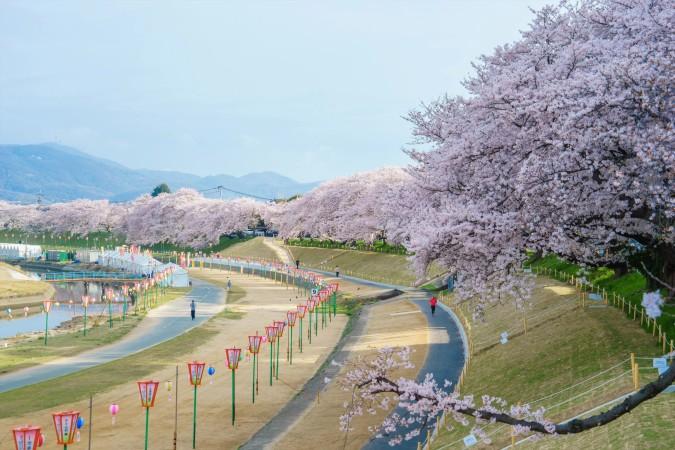
Cherry Blossom season during Spring in Okayama - © Okayama Tourism Official
Shopping in Okayama
Okayama's shopping options are a blend of traditional markets and modern retail. From unique local crafts to vibrant shopping districts, Okayama provides a rich and enjoyable shopping experience for visitors.
- Kibiji Craft Shops: Explore local craft shops in the Kibiji District, where you can find unique pottery, textiles, and other handcrafted items. These shops offer a glimpse into Okayama’s artisanal traditions and provide excellent opportunities for souvenir shopping.
- Okayama Station Shopping: The area around Okayama Station features a variety of department stores, boutiques, and specialty shops. It's a convenient spot to shop for fashion, electronics, and local products.
- Okayama Central Market: This bustling market is a great place to experience local life and purchase fresh produce, seafood, and regional delicacies. The market’s lively atmosphere and diverse offerings make it a must-visit for food lovers.
Essential Travel Information
Getting Around Okayama
Navigating Okayama is convenient with various transportation options available. With these transportation options, getting around Okayama and exploring its surroundings is straightforward and accessible.
- Public Transportation: Okayama boasts an efficient public transportation system, including buses and trains. The Okayama Electric Tramway connects key areas within the city, while the JR Okayama Station provides access to regional and national train routes, including the Shinkansen (bullet train).
- Car Rentals and Bike Rentals: For greater flexibility, consider renting a car to explore the surrounding areas. Bike rentals are also popular for local travel and offer an eco-friendly way to see the city’s sights.
- Access from Major Cities: Major Japanese cities are well-connected to Okayama. By train, Okayama is easily accessible from Osaka, Kyoto, or Hiroshima. The Okayama Airport also offers domestic and limited international flights, making travel convenient for visitors.
Looking for more adventures? Dive into Tokushima, another famous destination in Japan, with our article here.

Crusing Around Kurashiki Bikan - © iStock
ATM & Banking Services
Managing your finances in Okayama is straightforward with abundant banking services available. ATMs are widely distributed across the city, including in convenience stores, major shopping centers, and banks, accepting most international credit and debit cards for easy cash withdrawals. Many local banks provide services for tourists, such as currency exchange and banking assistance. While credit and debit cards are generally accepted at larger establishments, it’s a good idea to carry some cash for smaller shops, markets, and local services. Access to these banking facilities ensures a smooth and hassle-free experience, allowing you to focus on enjoying your visit.
Where to Stay in Okayama
With a variety of accommodation choices, Okayama ensures a comfortable and enjoyable stay for every traveler.
- Hotels: From luxury hotels to budget-friendly options, Okayama’s hotels provide comfortable and convenient lodging. Look for hotels near Okayama Station for easy access to transportation and local attractions.
- Ryokans Inns: Experience traditional Japanese hospitality by staying in a ryokan that offer tatami-matted rooms, futon bedding, and often include a meal as part of the stay. Ryokans in Okayama provide a unique cultural experience.
- Guesthouses and Hostels: Consider guesthouses or hostels as these accommodations offer a friendly atmosphere and are perfect for those looking for a more relaxed and affordable stay.
- Specialty Lodgings: Okayama also offers unique lodging experiences, such as capsule hotels and themed accommodations. These choices accommodate a range of tastes and can spice up your visit with something new.
Articles for you

Explore Yala National Park - Sri Lanka Travel, Asia
Tucked away in Sri Lanka’s southeastern corner, Yala National Park is where wild nature meets deep tradition. Known worldwide for its leopard population, the park is also home to elephants, sloth bears, crocodiles, and hundreds of bird species. Beyond wildlife, Yala opens doors to a cultural landscape dotted with ancient temples, Buddhist ruins, and coastal villages. For travelers seeking more than just a safari, Yala offers a chance to explore eco-tourism, local communities, and sacred heritage sites.
Population: The Yala National Park area doesn’t have a human population.
Economy: The economy around Yala National Park thrives on a blend of eco-tourism, agriculture, and local services. Safari tours, eco-lodges, and cultural experiences drive steady income for nearby towns like Tissamaharama and Kataragama, supporting thousands of families.
Landmarks: Famous for Block I of Yala and wildlife encounters, including elephants, sloth bears, crocodiles, and exotic bird species.

Explore Galle - Sri Lanka Travel, Asia
Nestled on Sri Lanka’s southern coastline, Galle is a vibrant city where history meets the sea. Its cobbled streets, colonial architecture, and serene beaches make it a must-visit destination for travelers seeking a blend of culture, adventure, and relaxation. A UNESCO World Heritage site, Galle captivates visitors with its Dutch Fort, bustling markets, and friendly locals. Whether you’re exploring the ramparts at sunset or savoring fresh seafood by the shore, Galle promises an unforgettable journey into Sri Lanka’s heritage.
Population: Approximately 113,000 in 2023.
Economy: Galle’s economy thrives on tourism, trade, and fisheries. The city’s historic fort, colonial architecture, and coastal charm draw thousands of international visitors each year, making tourism its main economic driver. Fishing remains vital for local livelihoods, supplying fresh seafood across the region.
Landmarks: Famous for the Galle Fort, Dutch Reformed Church & Maritime Museum, and Unawatuna Beach.

Explore Bentota - Sri Lanka Travel, Asia
Nestled along Sri Lanka’s southwestern coast, Bentota is a tropical paradise that blends golden beaches, vibrant culture, and thrilling adventures. Famous for its calm waters, luxury resorts, and scenic river estuary, Bentota has become a top destination for travelers seeking both relaxation and authentic experiences. From serene beach walks at sunrise to adrenaline-pumping water sports, this coastal town offers a perfect balance of leisure and exploration. With its proximity to Colombo and Galle, Bentota is easy to reach, making it an ideal stop for both short escapes and extended holidays.
Population: Approximately 37,000 in 2023.
Economy: Bentota’s economy thrives mainly on tourism, which drives local businesses such as hotels, restaurants, and wellness retreats. The town also benefits from fishing, coconut cultivation, and handicrafts like wood carving and batik textiles. Many residents rely on the growing demand for water sports and Ayurvedic treatments, making tourism the backbone of both income and employment in the area.
Landmarks: Famous for Bentota Beach, Bentota River Safari, and Kande Vihara Temple.

Explore Mirissa - Sri Lanka Travel, Asia
Mirissa is a charming coastal town on Sri Lanka’s southern shoreline. Known for its golden beaches, turquoise waters, and vibrant marine life, it has become a must-visit stop for travelers exploring the island. Many come for whale watching, surfing, and sunset views at Coconut Tree Hill, but Mirissa offers much more than postcard beauty. The fishing boats you see anchored by the bay carry generations of stories. Local traditions, delicious cuisine, and a laid-back rhythm of life shape every visitor’s experience.
Population: Approximately 4,700 in 2023.
Economy: Mirissa’s economy is largely shaped by its coastal location. Fishing has long been the backbone of local livelihoods, with generations relying on the Indian Ocean for income. In recent decades, tourism has become the main driver of growth, thanks to whale watching, surfing, and beachside hospitality.
Landmarks: Famous for Mirissa Beach, Coconut Tree Hill, and Parrot Rock Bridge.

Explore Nuwara Eliya - Sri Lanka Travel, Asia
Tucked away in the Central Highlands of Sri Lanka, Nuwara Eliya is often called “Little England”. With its rolling tea plantations, cool misty mornings, and colonial charm, this mountain town feels like a step into another world. Travelers come here to breathe fresh air, walk through flower gardens, sip the finest Ceylon Tea, and enjoy a pace of life far from the island’s busy cities. Whether you’re drawn by scenic landscapes, heritage architecture, or the warmth of its people, Nuwara Eliya is a destination that blends nature, culture, and history in perfect harmony.
Population: Approximately 781,000 in 2023.
Economy: Nuwara Eliya’s economy thrives mainly on tea production, as it sits in the heart of Sri Lanka’s central highlands, famous worldwide for Ceylon Tea. The city also benefits from a growing tourism industry, attracting visitors with its colonial charm, cool climate, and scenic landscapes.
Landmarks: Famous for Gregory Lake, Hakgala Botanical Garden, and Victoria Park.

Explore Sukau - Malaysia Travel, Asia
Nestled on the banks of the Kinabatangan River in Sabah, Malaysian Borneo, Sukau is a destination where wildlife, culture, and conservation come together. Known as one of Asia’s top spots for river safaris and eco-tourism, this quiet village offers a front-row seat to encounters with Bornean orangutans, pygmy elephants, proboscis monkeys, and exotic birdlife.
Population: Approximately 1,400 in 2019.
Economy: Sukau’s economy is shaped by its riverine location and natural resources. Traditionally, the Orang Sungai community relied on fishing, small-scale farming, and forest gathering for their livelihood. Today, the village has shifted toward eco-tourism, with river cruises, jungle trekking, and homestays providing income.
Landmarks: Famous for the Kinabatangan River cruises, Gomantong Caves, and Ox-bow lakes and wetlands.
